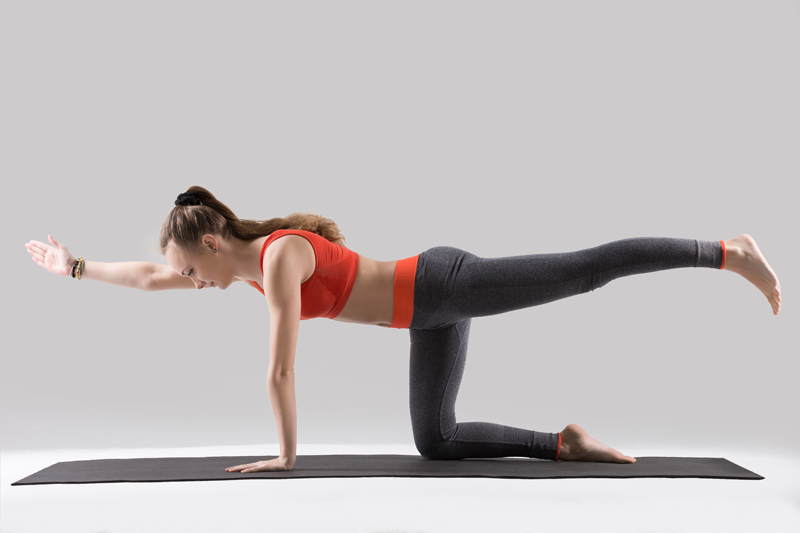
What is Face Yoga?
3rd January 2019
How to Change Your Body in Less Than a Month with Yoga
10th January 2019Yoga Poses to Help Hypotension

Hypotension, or low blood pressure, is a physical condition where the blood pressure levels drop below 90/60mm Hg. The condition is not considered harmful until it begins to cause fainting, dizziness, and shock. However, it can bring with it a number of unpleasant symptoms including headaches, chest pain, diarrhoea and vomiting.
Hypotension can be caused by various different things including anaemia, low blood volume, nutritional deficiency, and hormonal changes. In some cases, the condition prevents oxygen and nutrients from reaching the brain and other vital organs; this is where it becomes dangerous. Thankfully, yoga can be used to treat the effects of hypotension and prevent unpleasant symptoms. In this article, we explore the best yoga poses to help hypotension. Before getting started, it’s important to pick up the right gear. To keep the muscles warm whilst you practice, consider wearing a long-sleeved yoga top and a comfy pair of leggings.
Boat Pose
To practice Boat Pose, sit down on the floor with your legs straight out in front of you. Next, place your hands on the floor behind your hips with your fingertips are pointing towards your feet. Press your palms firmly into the ground and straighten your arms. Keeping your back straight, gently lean back and lift your feet off the ground. Your shins should now be parallel to the floor. As you lift your chest, lengthen the front of your torso. Finally, extend both arms forward until they are in line with your shoulders. You are in Boat Pose. Hold the pose for 30 seconds whilst breathing deeply. For best results, draw your chin into your chest throughout the pose. This action brings the base of the skull away from the neck and allows the body to enjoy a deeper stretch.
Camel Pose
To practice Camel Pose, kneel on your mat with your knees under your hips and your shins parallel. Next, reach your right arm back towards your right foot and your left towards your left foot. For additional support, grab ahold of your feet if you need to. To avoid leaning your weight on your hands, try to shift your weight onto your knees. This will also increase the stretch in your stomach and chest. Finally, tilt your head back as much as possible. You are in Camel Pose. Hold the asana for around 30 seconds before moving onto the next asana.
Chair Pose
To practice Chair Pose, stand tall with your big toes touching. Taking a deep breath in, raise your arms above your head and point your fingertips toward the ceiling. Draw both your shoulders back as you lengthen your neck. As you exhale, bend your knees and lower your bottom down and back, much like you would when sitting on a chair. At this stage, it’s important to not let your knees extend past your toes. Each time you inhale, lengthen your spine a little more. With each breath out, deepen the stretch by lowering your bottom further toward the floor. You are in Chair Pose. For best results, keep your abdominal muscles engaged and your thighs touching throughout. Hold the posture for 30 seconds whilst breathing deeply.

Triangle Pose
To practice Triangle Pose, begin standing with your feet apart. Bring your arms out to the sides until they’re in line with your shoulders. Turn your right foot out 90 degrees and your left foot in 45 degrees. Engaging your quadriceps, bend to the side over your right leg. For support, place your right hand on your ankle, shin, or knee. Finally, lift your left arm towards the ceiling and gaze at your fingertips. You are in Triangle Pose. Hold the asana for 30 seconds before repeating on the opposite side.
Half Frog Pose
To practice Half Frog Pose, lie flat on your stomach. Next, gently bend your elbows and prop yourself up on your forearms. At this point, ensure that your forearms are parallel to each other. Turn your left arm until your fingers point toward the top left corner of your mat. Bending your left knee, gently reach your left arm back to grab ahold of your left foot. To increase the stretch, slowly pull your foot in towards your bottom. You are in Half Frog Pose. Hold the posture for 30 seconds before repeating on the opposite side.
Mountain Pose
To practice Mountain Pose, begin standing with your feet together. Press down through your toes as you spread them apart. Tense your quadriceps to lift your kneecaps, then lift yourself up through your inner thighs. As you lift your chest, draw your stomach in and up and press your shoulders down. Bring your shoulder blades together to open your chest, keeping your palms facing inwards. You are in Mountain Pose. Hold the asana for around 30 seconds whilst breathing deeply.
Tree Pose
To practice Tree Pose, stand tall with your feet together. Touch your big toes together, leaving half an inch of space between your heels. Next, bring your palms together in front of your chest and engage your abdominal muscles. Slowly shift your weight onto your right foot, rooting it down by pressing firmly through the ball of your heel. Gently lift your left foot off the ground, bending the knee as you do so. When you’ve established a sense of balance, place your left foot on the inside of your right thigh. You are in Tree Pose. Hold the posture for 30 seconds before switching sides.
In Summary
Whether you’re already suffering from hypotension or you’re hoping to prevent its onset, practice the yoga poses above to stay healthy. If you’re new to yoga, consider attending a weekly class before practising independently. There, an instructor can ensure you’re using the postures correctly. Before your first session, pick up a supportive yoga bra and some breathable bottoms.

